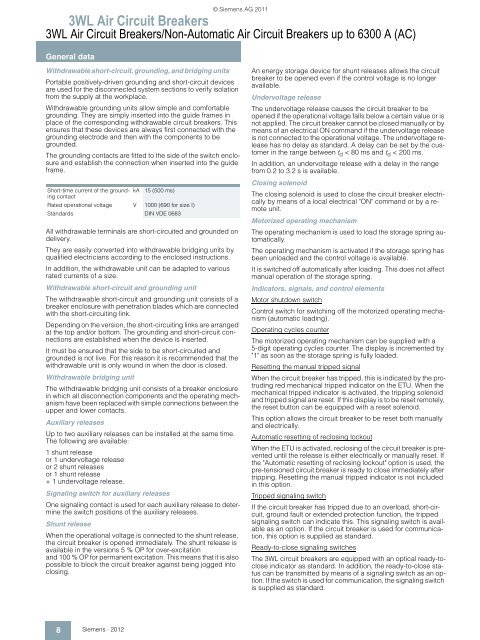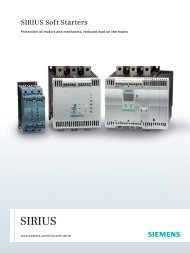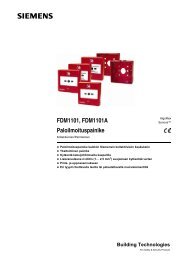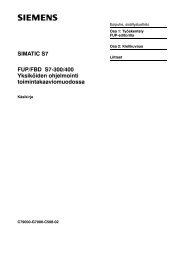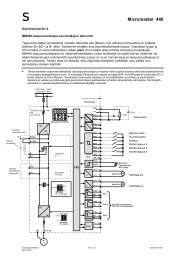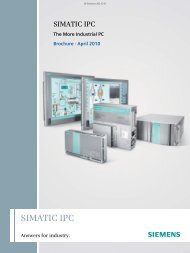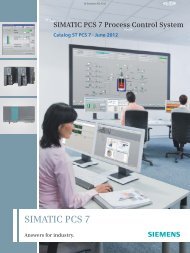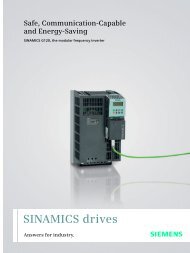Configuration Manual for Catalog LV 10.1 · 2012 - Siemens
Configuration Manual for Catalog LV 10.1 · 2012 - Siemens
Configuration Manual for Catalog LV 10.1 · 2012 - Siemens
Create successful ePaper yourself
Turn your PDF publications into a flip-book with our unique Google optimized e-Paper software.
3WL Air Circuit Breakers<br />
3WL Air Circuit Breakers/Non-Automatic Air Circuit Breakers up to 6300 A (AC)<br />
General data<br />
© <strong>Siemens</strong> AG 2011<br />
Withdrawable short-circuit, grounding, and bridging units<br />
Portable positively-driven grounding and short-circuit devices<br />
are used <strong>for</strong> the disconnected system sections to verify isolation<br />
from the supply at the workplace.<br />
Withdrawable grounding units allow simple and com<strong>for</strong>table<br />
grounding. They are simply inserted into the guide frames in<br />
place of the corresponding withdrawable circuit breakers. This<br />
ensures that these devices are always first connected with the<br />
grounding electrode and then with the components to be<br />
grounded.<br />
The grounding contacts are fitted to the side of the switch enclosure<br />
and establish the connection when inserted into the guide<br />
frame.<br />
Short-time current of the grounding<br />
kA 15 (500 ms)<br />
contact<br />
Rated operational voltage V 1000 (690 <strong>for</strong> size I)<br />
Standards DIN VDE 0683<br />
All withdrawable terminals are short-circuited and grounded on<br />
delivery.<br />
They are easily converted into withdrawable bridging units by<br />
qualified electricians according to the enclosed instructions.<br />
In addition, the withdrawable unit can be adapted to various<br />
rated currents of a size.<br />
Withdrawable short-circuit and grounding unit<br />
The withdrawable short-circuit and grounding unit consists of a<br />
breaker enclosure with penetration blades which are connected<br />
with the short-circuiting link.<br />
Depending on the version, the short-circuiting links are arranged<br />
at the top and/or bottom. The grounding and short-circuit connections<br />
are established when the device is inserted.<br />
It must be ensured that the side to be short-circuited and<br />
grounded is not live. For this reason it is recommended that the<br />
withdrawable unit is only wound in when the door is closed.<br />
Withdrawable bridging unit<br />
The withdrawable bridging unit consists of a breaker enclosure<br />
in which all disconnection components and the operating mechanism<br />
have been replaced with simple connections between the<br />
upper and lower contacts.<br />
Auxiliary releases<br />
Up to two auxiliary releases can be installed at the same time.<br />
The following are available:<br />
1 shunt release<br />
or 1 undervoltage release<br />
or 2 shunt releases<br />
or 1 shunt release<br />
+ 1 undervoltage release.<br />
Signaling switch <strong>for</strong> auxiliary releases<br />
One signaling contact is used <strong>for</strong> each auxiliary release to determine<br />
the switch positions of the auxiliary releases.<br />
Shunt release<br />
When the operational voltage is connected to the shunt release,<br />
the circuit breaker is opened immediately. The shunt release is<br />
available in the versions 5 % OP <strong>for</strong> over-excitation<br />
and 100 % OP <strong>for</strong> permanent excitation. This means that it is also<br />
possible to block the circuit breaker against being jogged into<br />
closing.<br />
An energy storage device <strong>for</strong> shunt releases allows the circuit<br />
breaker to be opened even if the control voltage is no longer<br />
available.<br />
Undervoltage release<br />
The undervoltage release causes the circuit breaker to be<br />
opened if the operational voltage falls below a certain value or is<br />
not applied. The circuit breaker cannot be closed manually or by<br />
means of an electrical ON command if the undervoltage release<br />
is not connected to the operational voltage. The undervoltage release<br />
has no delay as standard. A delay can be set by the customer<br />
in the range between t d < 80 ms and t d < 200 ms.<br />
In addition, an undervoltage release with a delay in the range<br />
from 0.2 to 3.2 s is available.<br />
Closing solenoid<br />
The closing solenoid is used to close the circuit breaker electrically<br />
by means of a local electrical "ON" command or by a remote<br />
unit.<br />
Motorized operating mechanism<br />
The operating mechanism is used to load the storage spring automatically.<br />
The operating mechanism is activated if the storage spring has<br />
been unloaded and the control voltage is available.<br />
It is switched off automatically after loading. This does not affect<br />
manual operation of the storage spring.<br />
Indicators, signals, and control elements<br />
Motor shutdown switch<br />
Control switch <strong>for</strong> switching off the motorized operating mechanism<br />
(automatic loading).<br />
Operating cycles counter<br />
The motorized operating mechanism can be supplied with a<br />
5-digit operating cycles counter. The display is incremented by<br />
"1" as soon as the storage spring is fully loaded.<br />
Resetting the manual tripped signal<br />
When the circuit breaker has tripped, this is indicated by the protruding<br />
red mechanical tripped indicator on the ETU. When the<br />
mechanical tripped indicator is activated, the tripping solenoid<br />
and tripped signal are reset. If this display is to be reset remotely,<br />
the reset button can be equipped with a reset solenoid.<br />
This option allows the circuit breaker to be reset both manually<br />
and electrically.<br />
Automatic resetting of reclosing lockout<br />
When the ETU is activated, reclosing of the circuit breaker is prevented<br />
until the release is either electrically or manually reset. If<br />
the "Automatic resetting of reclosing lockout" option is used, the<br />
pre-tensioned circuit breaker is ready to close immediately after<br />
tripping. Resetting the manual tripped indicator is not included<br />
in this option.<br />
Tripped signaling switch<br />
If the circuit breaker has tripped due to an overload, short-circuit,<br />
ground fault or extended protection function, the tripped<br />
signaling switch can indicate this. This signaling switch is available<br />
as an option. If the circuit breaker is used <strong>for</strong> communication,<br />
this option is supplied as standard.<br />
Ready-to-close signaling switches<br />
The 3WL circuit breakers are equipped with an optical ready-toclose<br />
indicator as standard. In addition, the ready-to-close status<br />
can be transmitted by means of a signaling switch as an option.<br />
If the switch is used <strong>for</strong> communication, the signaling switch<br />
is supplied as standard.<br />
8 <strong>Siemens</strong> · <strong>2012</strong>


